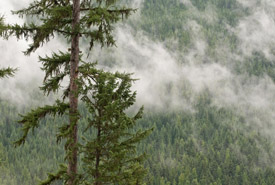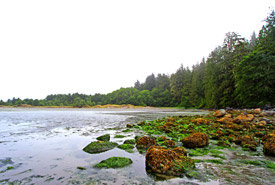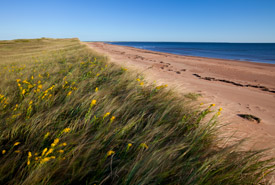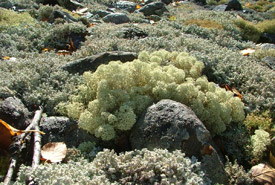What is climate change adaptation? (Part One)

Misty Darkwoods forest, BC (Photo by Bruce Kirkby)
Did you ever ask yourself this question? If not, you should. If yes, you’re not the only one! Two national events that occurred in 2016 are a testimony to the importance and complexity of this question.
Impacts of climate change

An intertidal zone on Clayoquot Island (Photo by NCC)
Much work has been done worldwide to develop models that can better forecast the impact of greenhouse gas emissions on the Earth’s climate. Climate scientists are more and more confident on the worldwide and regional projections made by those models. It is now possible to get a better sense of what is likely going to happen in our communities for a variety of carbon emissions scenarios. As temperatures increase, the effects of climate change will become increasingly evident and more frequent, such as increased flooding and storm intensity, sea level rise and drought.
To adapt, or not to adapt?
In the not-so-distant past, investments on climate change adaptation were often thought of as money that would have been better spent on reducing greenhouse gas emissions. But now there is general agreement that significant impacts from changes in the Earth’s climate are unavoidable and irreversible, no matter how hard we try to bring down our greenhouse gas emissions. So what are we supposed to do now?
Adaptation Canada 2016
On April 12-14, 2016, the Adaptation Canada 2016 conference held in Ottawa was the first national event that focused primarily on climate change adaptation programs. More than 600 delegates from industry, government, non-governmental organizations, academics, decision-makers and practitioners in various fields, including conservationists, shared innovative ways in which Canadians can prepare to live in a different climate. Many of those initial steps were taken by municipal governments to ensure that community members will have a safe environment to live in the future.
How does the Nature Conservancy of Canada fit in with all of this?

Conway Sandhills, Prince Edward Island (Photo by John Sylvester)
The Nature Conservancy of Canada (NCC) is a leader in science-based conservation planning, which aims to identify priority lands for conservation and steward them for the long-term. As such, NCC is well-positioned to support land use planning approaches that incorporate nature-based solutions that help reduce the impacts of climate change and help nature and people adapt to climate change.
Conserving nature is a critical dimension of responding to climate change, as it provides green infrastructure that can help communities better cope with the changes to come. For example, nature can help by:
- slowing the release of water during heavy rainfall events and absorbing wave energy during storms, hence protecting private properties against damages from floods or coastal erosion;
- storing water that can be slowly released during periods of drought, ensuring that communities have a constant supply of freshwater;
- cooling air during heatwaves and protecting vulnerable people from extreme heat events;
- ensuring that wildlife species can move to different habitats as their usual habitats become unsuitable for their survival. This is also important for food security and economic reasons, as it allows communities to maintain food and revenue sources associated with nature.
Nature absorbs and stores carbon

Mosses and lichens in northwestern Ontario (Photo by NCC)
On top of it all, our forests, grasslands and wetlands have absorbed a vast amount of carbon dioxide and stored it for thousands of years. With more than a quarter of the world’s northern forests and a quarter of the world’s wetlands, Canada’s natural systems play an important role as globally significant carbon sinks.
It is essential that we keep this cycle working: conserving Canada’s existing natural ecosystems not only avoids the release of stored carbon but it promotes continuous and ongoing storage of large amounts of CO2. Further conservation of our natural ecosystems will help ensure that future emissions are lower than what might otherwise have occurred.
Priority actions for NCC
During a panel on “Biodiversity and People in a Changing Climate” during the Adaptation Canada 2016 conference, NCC suggested the following priority actions:
- Conserve and connect our natural ecosystems to maintain their capacity to store and sequester carbon, limit climate change effects on nature and people and provide opportunities to adapt to a new climate; and
- Build capacity to allow communities and institutions to:
- understand the effects of climate change on natural ecosystems;
- emphasize nature’s important role in climate change adaptation, and plan, implement and monitor effective adaptation actions;
- continue efforts to share and identify best practices and accessible adaptation tools that can be used across Canada.
See recommended actions from the panel >
Stay tuned for Part Two of my blog on September 2, 2016, in which I will provide more examples of how NCC is involved in helping Canada adapt to climate change.


